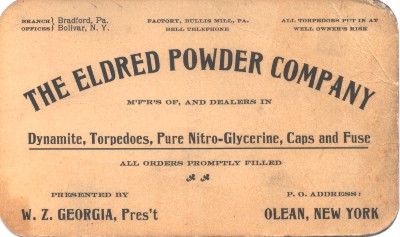

|
The production of dynamite and nitro-glycerine was one of the first major industries located in the Eldred vicinity. Nitro was most often used in the oil fields to shoot wells. Glycerine is an extremely explosive combination of powerful acids, completely colorless and heavy. An eight quart can of nitro could weigh in at 26 pounds. The manufacturing of nitro-glycerine and dynamte are relative easy but poor monitoring the temperatures during mixing stages could result in a devastating explosion. As would be the case, explosions rocked the Eldred area from the 1880's through the late 1960's. Most of these explosions took place at National Powder and were occasionally deadly. The earliest recorded explosion took place
on January 3, 1885, when the George Dana glycerine factory exploded
taking the lives of mixer J. Simmons and a young boy hanging around
the mixing house named C. Thompson. The Eldred Powder Company blew up claiming the life of Charles Brown in 1906. |
|
 |
Byron
Alford (1842 - 1898) In the fall of 1866 he located at State Line Mills, and was postmaster while there. From the spring of 1867 to the fall of 1869 he operated the State Line Lumber-Mill for Calvin T. Chamberlin, of Cuba. N. Y. In the fall of 1869 he bought a lumber-mill in Eldred township, and began the manufacture of lumber on his own account. The following year he erected another mill within forty rods of the first. In 1871 he formed a partnership with E. F. Johnson, of Oramel, N. Y., which included the above business, and which existed until the fall of 1874. In the fall of 1877 he embarked in the oil business as a producer of twenty wells and sole owner of seven wells in the Bradford field. Late in the fall of 1879 he began the construction of a large saw-mill at Barnum, Cattaraugus Co., N. Y., on a contract with Weston Bros., of Weston's Mills and subsequently entered into partnership with A. R. Curtiss, under the firm name of Alford & Curtiss, and conducted an extensive lumber and mercantile business for about three years. In 1883 he engaged in the manufacture of explosives used for all kinds of blasting purposes, with J. W. Dean, under the firm name of Alford & Dean, which partnership existed until July, 1888, when Mr. Alford purchased his partner's interest. Alford married Mary Elizabeth Irish (1846 - 1924) in Olean in 1884. She also studied the business of explosives and she officially took over the business when Byron died in 1898. Although she had been running the business six years prior due to his ill health. |
| At the time Mary Alford was the only woman in the world who owned and managed a nitro-glycerine and dynamite factory. She did most all of the business duties including; purchasing chemicals, pay roll, sales, billing and shippng, hands on visiting of the factory manufacturing. She was known to keep late nights working until midnight. In 1899, Mrs Alford was rated at $35,000.00 (at her own request), but her properties' were actually valued closer to $80,000. She owned and managed a large oil lease, owned several Eldred village properties and several hundred acres of land. |
|
Nitro-Glycerin Well Shooting
|
 When the flow of oil moved slowly from a well, it is necessary to enlarge the well by explosives. For many years this was done by nitro-glycerine shoots. A "Go-Devil" torpedo was filled with as many as 60 to 200 quarts of nitro. The torpedo would be 8 to 10 feet in length depending on the size of the shoot. A copper constructed can contained slightly more than 10 quarts. These cans were nicknamed "Angel Cans" because one wrong move and the handler of the can was with the angels above. |
 |

|
National Powder Explosives
truck photographed at Spike Slavin's garage.
(standing at right is Guy Moses) |
 |
 |

 |
 |
